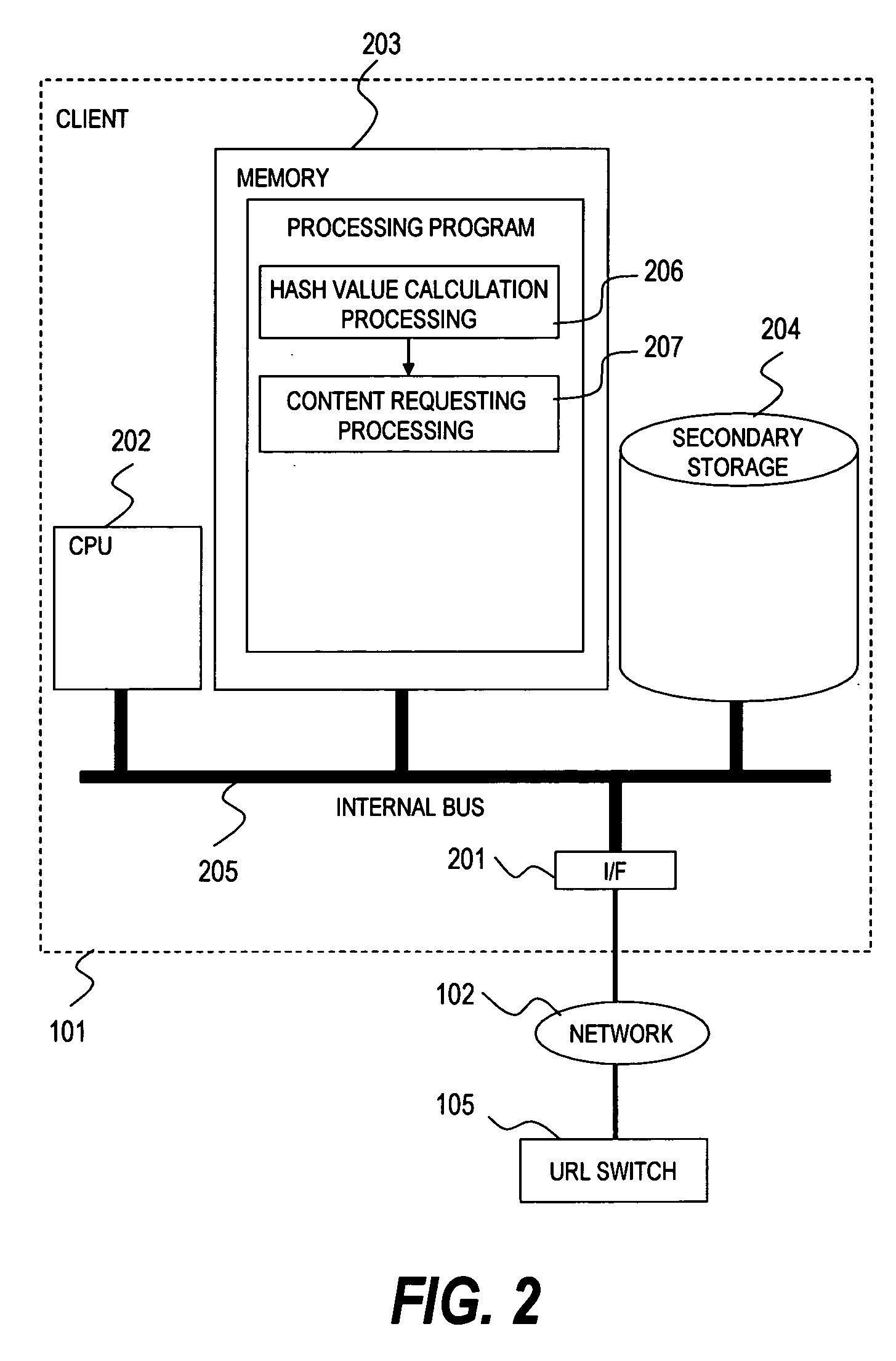Computer system with a packet transfer device using a hash value for transferring a content request
a technology of a computer system and which is applied in the field of computer systems with a packet transfer device, can solve the problems of requiring a great deal of processing ability and storage capacity, and it is difficult with the conventional method to achieve speedy and economical processing, so as to improve the performance speed up the processing of the url switch. , the effect of reducing the number of requests
- Summary
- Abstract
- Description
- Claims
- Application Information
AI Technical Summary
Benefits of technology
Problems solved by technology
Method used
Image
Examples
first embodiment
[0051]FIG. 1 is a block diagram showing a configuration of a computer system according to a first embodiment.
[0052] The computer system of the first embodiment is composed of client terminals 101-1 to 101-n, a network 102, and a server group 104.
[0053] The server group 104 includes a plurality of Web servers 104-1 to 104-m and a URL switch 105. The Web servers 104-1 to 104-m are computers for providing content to the client terminals 101-1 to 101-n. The URL switch 105 is a load balancer for analyzing content requests (URLs) sent from the client terminals 101-1 to 101-n and allocates the content requests to the Web servers 104-1 to 104-m.
[0054] The network 102 connects the client terminals 101-1 to 101-n to the server group 104, and employs as a communication protocol TCP / IP, for example.
[0055] The client terminals 101-1 to 101-n are computers for requesting content from the Web servers 104-1 to 104-m by way of HTTP. A proxy server 103 is provided between the client terminal 101-...
second embodiment
[0113] Described next is an example of applying this invention to a computer system that has a distributed cache.
[0114] A cache server is placed between a client terminal and a content server (origin server). The cache server responds to a content request made by the client terminal in place of the content server, to thereby cut short the time required to respond to the client terminal, lessen the load on the content server, and reduce traffic between the cache server and the content server.
[0115] A cache server housing more client terminals stores more common content requested by a plurality of client terminals, and the cache hit ratio is accordingly improved.
[0116] However, the cache server may receive more content requests from that many client terminals than it is capable of processing, thus causing a bottleneck. The cache server bottleneck can be avoided while the amount of stored content is increased by dividing client terminals among a plurality of cache servers and sharin...
third embodiment
[0219] In the first and second embodiments, a hash value is buried in a packet that is exchanged after a session is established between a server and a client terminal. A third embodiment described below uses a packet in which a hash value is buried when a TCP session is established.
[0220]FIG. 24 is an explanatory diagram of a TCP header format according to the third embodiment.
[0221] A packet transmitted when a TCP session is established has a SYN flag set in a TCP header control bits to indicate that the packet is a request to establish a session. In the third embodiment, a hash value of a URL at which requested content is located is buried in TCP options of the SYN packet.
[0222] It is therefore necessary in implementing the third embodiment to modify an existing TCP stack that is installed to a client terminal. Accordingly, which one of the method of the first and second embodiments and the method of the third embodiment is employed should be determined in accordance with the u...
PUM
 Login to View More
Login to View More Abstract
Description
Claims
Application Information
 Login to View More
Login to View More - R&D
- Intellectual Property
- Life Sciences
- Materials
- Tech Scout
- Unparalleled Data Quality
- Higher Quality Content
- 60% Fewer Hallucinations
Browse by: Latest US Patents, China's latest patents, Technical Efficacy Thesaurus, Application Domain, Technology Topic, Popular Technical Reports.
© 2025 PatSnap. All rights reserved.Legal|Privacy policy|Modern Slavery Act Transparency Statement|Sitemap|About US| Contact US: help@patsnap.com



